November/December 2010
Soggy is as Soggy Does...
Adventures in Iberia
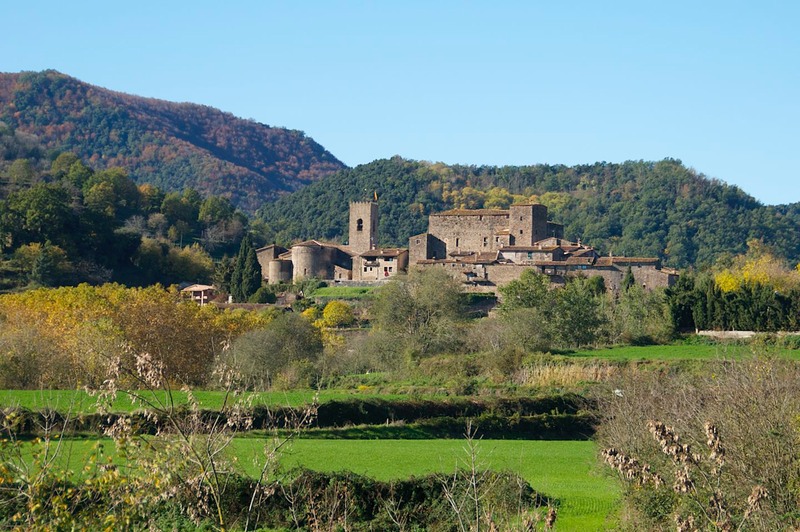
Yes, Virginia, it is warmer in Spain and Portugal – some -- but wetter. What ever made us think we would be getting out our shorts down here on the Iberian Peninsula?
We hightailed it out of France, looking for that mythical land of sunshine, luscious oranges, and toreadors. We have found evidence of all three, and a whole lot more, but we’ve also gotten pretty damp. But enough of the whinging; Spain and Portugal are both great travel destinations: we’ve seen some beautiful places, and – disparaging comments aside -- we have had a lot of terrific, sunshine-filled days; we have the pictures to prove it.
The general consensus, when heading south for better weather, seems to be to beat feet for the beach. Well, we aren’t really beach people; we prefer mountains (or at least hilly country), dirt rather than sand, and, as you probably already know, Rick only likes fish when it’s deep-fried and served up with chips. So we charted a more inland route for ourselves. As it turned out, we saw some lovely areas and great little hamlets, and kept ourselves off the beaten track for the most part. Of course, this also kept us at higher altitudes and lower temperatures.
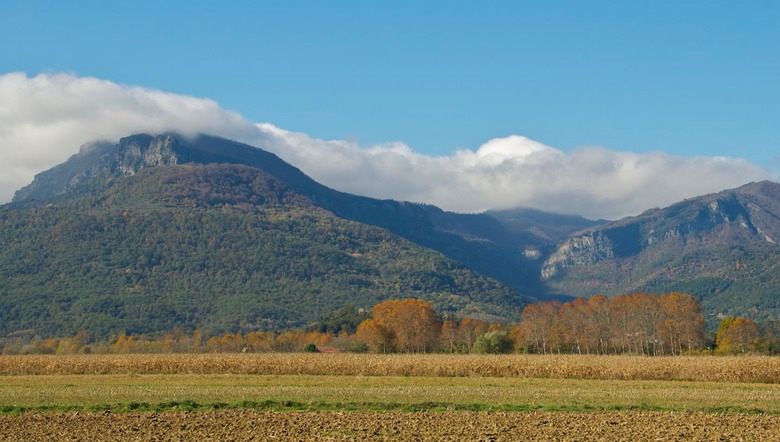
But wait, wait – we did start out on the coast. We crossed into Spain at the eastern edge of the Pyrénées, just south of Perpignan. We felt at home in the dry Mediterranean countryside: brown hills, scrubby trees, and lots of cactus. We were in the Catalunya region, the northeastern corner of Spain; the language we were hearing was Catalan. This is a proud and independent area, just as is the Basque region that occupies a similar position at the western edge of the Pyrénées. Each of these areas would like to be completely independent from Spain, but until that happens they uncomfortably co-exist with the mother country as they have for centuries.
We badly wanted to see the Salvador Dali museum in Figueres, so we started in that coastal community. Unfortunately, the museum is now closed on Mondays in the winter, and we missed out. We took pictures of the outside of the building, which really does represent the great artist at his best, and planned a return visit down the road. While in Figueres we found our first outdoor fruit seller, and bought a new supply of oranges. They still weren’t as sweet as we would have liked, but they were definitely fresh, and quite beautiful – high marks on both counts.
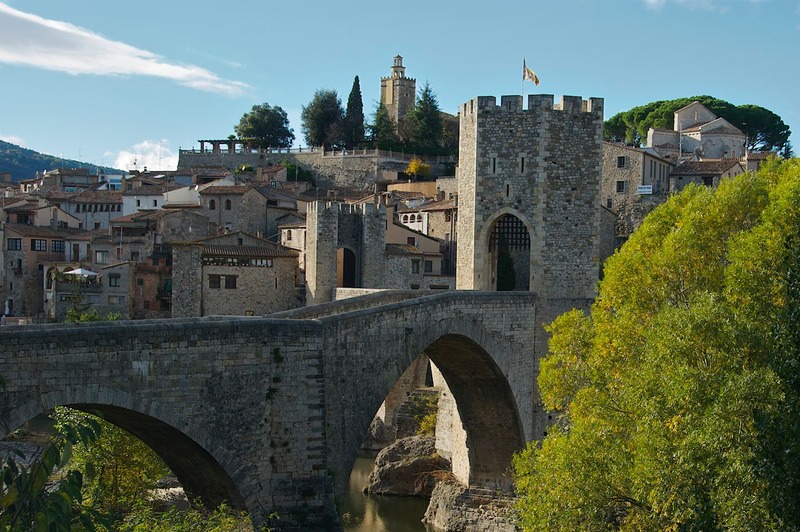
As we moved south, we were also moving west, as we wanted to be inland. We headed back into the mountains, intending to take a road over a high ridge; instead, all of a sudden, without much warning, we entered the first of a series of tunnels, and in about 10 miles found we had popped out on the other side. Damn! So much for a windy road across the peaks. Well, okay; we wandered on, poking around a dozen charming medieval towns like Besalú, with its fortifications and bridge over the river that’s the main entry into the small hill town. Generally speaking, we were heading towards Zaragoza, a city that would be large enough for us to discover whether or not we would be able to get a SIM card for our wifi apparatus (no, of course not).
We find, by the way, that Emily is once again bemused. Spain is rapidly evolving its road system, and there are new roads/new roundabouts/new ways in and out of towns – everywhere. Bemused is putting it kindly; poor child. And, another treat: yet more new words for speed bumps – bandas sonoras and pasos elevados; the versions never end; someday we’ll publish the definitive guide to the many ways of saying “$#*@!?... Speed Bump”.
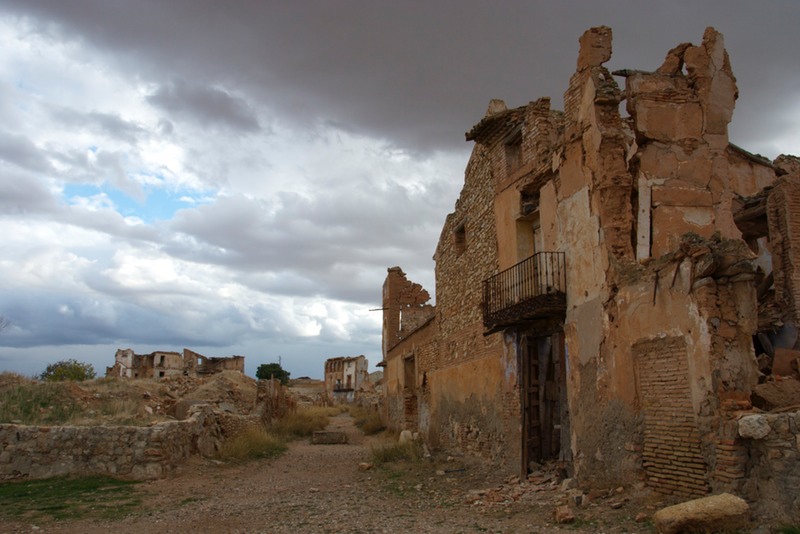
We picked a route that would take us through the abandoned town of Belchite, which we did not want to miss. Belchite was bombed by Generalissimo Franco during the Spanish Civil War; he basically destroyed the place. The townspeople, rather than rebuild, chose to leave the village just as it was, and built a new community nearby. Belchite stands as a reminder of just how effective aerial bombing can be. There is free access; little has been done except to mark off a few areas for safety reasons. You wander the streets and think you’ve gone back in time to World War II. It’s just plain chilling. The community provides information and gives talks.
Part of the interior of Spain that we passed through is the area of La Mancha. And yes, we did see windmills; Cervantes is revered here. Swinging past Cuenca, we tried to spend some time, but this charming and popular hill town where we’d spent delightful days on an earlier visit has too many big city aspects, including driving hazards that almost got us clobbered. We gave up, at least for this round.
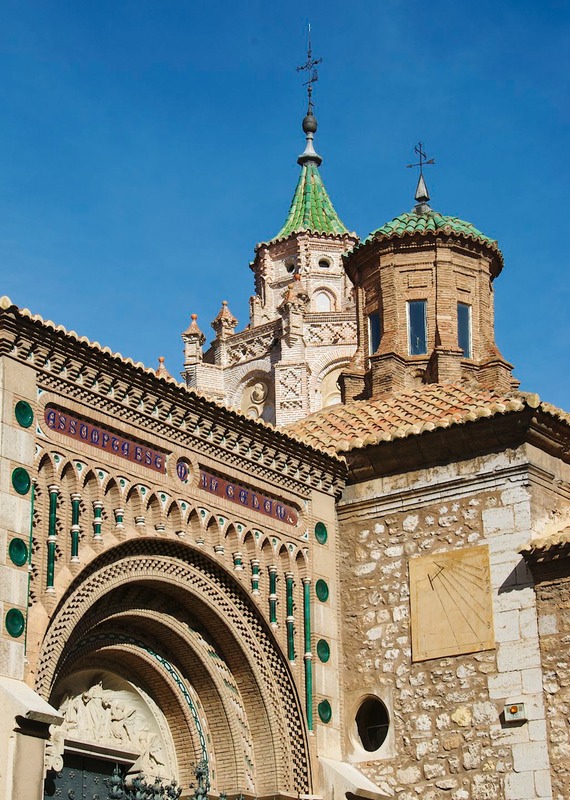
We continued dropping southwest, heading toward the highpoints of Moorish Spain in Andalucia. Teruel gave us a start, with its intricate towers. The great cities of Granada, Córdoba and Seville lay ahead. The topography was now alternating between dry/arid, to more vineyards and orchards. We spent several nights parked alongside reservoirs formed by damming rivers to provide irrigation for the crops. It was very nice. And there was still snow on the highest peaks from the last storms.
The further south we got, the larger the field operations were: huge olive orchards, vineyards that stretched for miles, wind farms, and now for the first time enormous solar farms, with flat panels stretched out everywhere in the sun. We dropped down into the Jaén area, the home base of the olive operation in Spain, and then finally to Granada, with snow on the high peaks east of the city.
As you can tell, we traveled to Spain once before, almost 20 years ago. So we are bypassing some cities that others might consider essential visits. But Granada and the Alhambra were worth a return trip. We tried to time our visit to the Alhambra for good weather, but ended up being there during a cold (36 degrees when we started out) and rainy day. No matter, the place is awesome. The palace, which most people concentrate on, was built during the 1300s; there is also the surrounding fort and gardens with pools and fountains. There are endless carving details, lovely columns and tile work, graceful arches, a delight everywhere you turn. It was terrific. We got there early, and were even able to find a place to park right at the site; for us, this is very unusual. There also was an unexpected treat in one building, provided by a temporary exhibit of some of Matisse’s paintings. He had visited the Alhambra and spent time in Granada in 1910, and the influences are very apparent. It was an excellent exhibit, and quite informative.
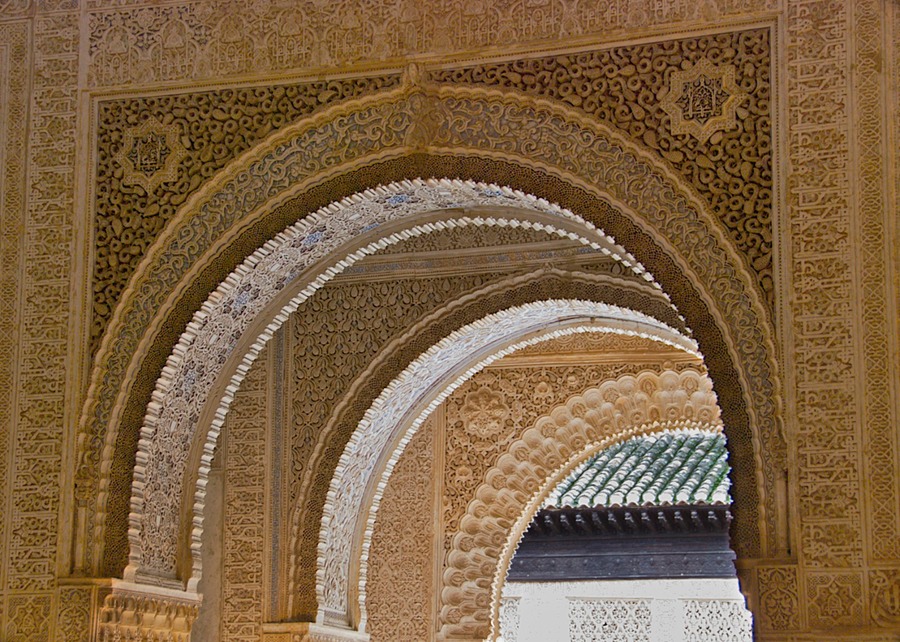
Trekking on through many a tiny village with its narrow and crooked streets; past the olive groves that reminded us of the area around Ojai (south of Santa Barbara), we arrived in Córdoba. Now this was a new city for us, and what a treat. Córdoba is a little out of the way, but if you get to Spain, don’t skip it.The whole city is a delight, in part because it is filled with orange trees. They even have a decent place for us big guys to park, and it’s near the old city. And then you arrive at La Mezquita, the mosque built by the Moors over 1200 years ago and captured by the Christians several centuries later. This structure is something else, with its incredible repeating columns, sense of space and grandeur. You will never forget how you felt when you first walked in and then turned left to get your first view of the interior. It was very difficult to photograph (anyone who has visited will understand), but we hope our offerings will give you some sense of its beauty. During our visit we enjoyed lovely warm weather with bright sunshine and light breezes; just perfect, and it made the day extra special.
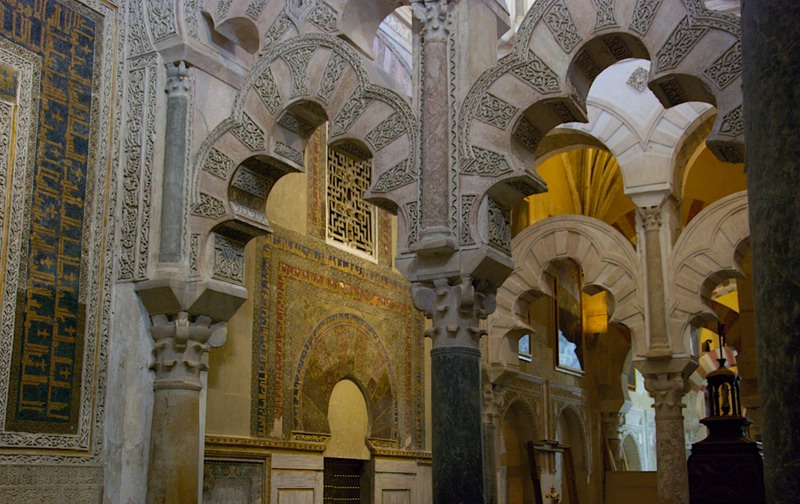
The next day the weather had turned on us. We intended to visit the Madinat al-Zahra in the hills outside Córdoba. This was the location of the ruins of an enormous palace complex completed in 961. There is a new (very nice) visitor’s center nearby, and we spent a lot of time there, learning about the location and the findings that have already been made. Unfortunately, the staff agreed with us that there was no point in visiting the archeological site in the rain and fog; we will come again another time. Don’t miss it!
We moved further west, toward Seville. Now there were more oranges than olives; the hillsides were lovely. This area gets more rain, apparently; there were wildflowers and pampas grass beside the roads, we saw palm trees in the towns, and even green grass in the fields. We followed along the Guadalquiver River, which eventually flows through Seville. The area was full of small farming towns filled with big farming equipment; large-scale agriculture and citrus groves; irrigation canals and drip lines through the fields. For some reason I kept thinking of Central America. Maybe it was the color of the dirt.
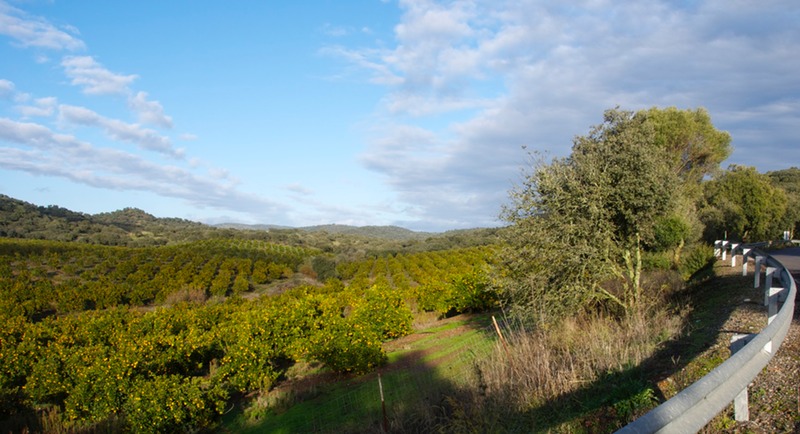
Nearing Seville, we made a delightful stop in the small Moorish town of Carmona. This is very nice countryside. We wandered at will, enjoying the whitewashed walls, the towers of the churches, and the old guys enjoying their warm Sunday morning in the park. Due to the narrow lanes, we were never able to see an entire church except up close; but the towers peeking over the tops of the buildings were charming. This would be a great town to settle down in for a few days; there were concerts coming up as well as a horse show; a happening place.
Sadly, we have to tell you that Seville never happened for us. Parking is a real issue in these cities; we tried to position ourselves at a spot we’d read about that was close to the city, in a marina, with a bus stop nearby. We actually even found the place, but it was gated and we couldn’t raise anyone to let us in. We learned about another spot, but it was junky and too far out, with no public transportation at hand. However, we do have a line on a large parking area in the city now, and intend to give it another go in the spring. We want to see Seville!
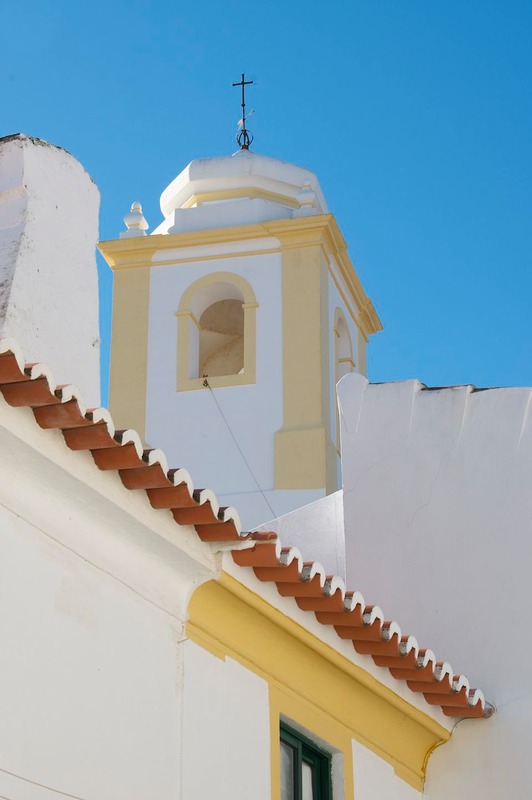
Emily thinks the road named N-IVa should be pronounced “North Iva” but it’s actually the N4a; the poor dear. We think she needs a rest. Do you think she’ll be happier in Portugal? We promise to let you know.
* * * * * * *
So now (ta da!) – Portugal it is! We hopped across the border and landed ourselves in a beach town called Castro Marim. It looked just like a beach town ought to: sand, palm trees, kinda run down but friendly; this one also had a fortress on a hill, so we knew were were still in Iberia. Our first pleasant surprise: Portugal is an hour earlier than Spain; the sun came up at a very respectable hour in the morning.
We stayed in Castro Marim for a couple of days; the town had a very nice library, complete with internet access, for one thing. Also, it was balmy, there were several British couples parked nearby to chat with, and we were feeling pretty good about the world. But we did want to see as much of Portugal as possible, so soon we pulled out and began our visit by touring the southern part of the country.
And suddenly we were in love again; first Wales, then Scotland, and now Portugal. This is one terrific country! We stopped in many small villages, each one more interesting and photogenic than the last, all with whitewashed buildings trimmed in the typical blue, ochre and yellow of the region. There were churches, fortresses and castles, monuments, the ruins of Roman temples, and bullrings in every city.
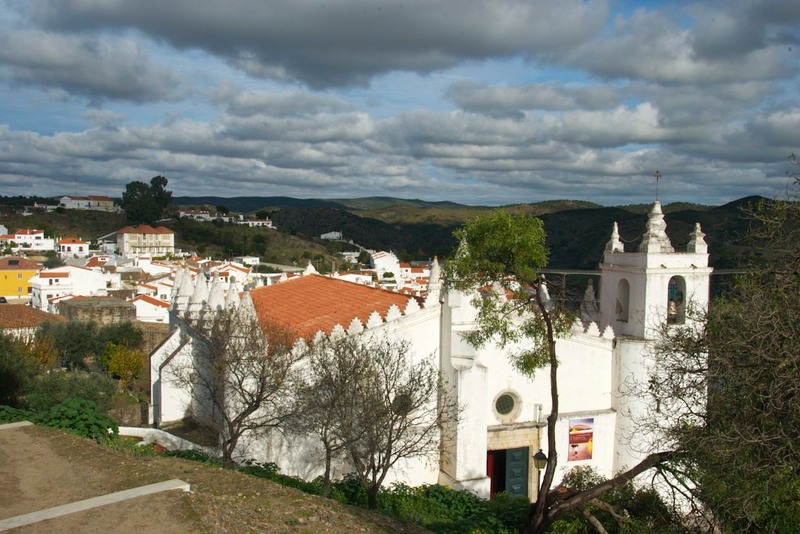
Other than the bullrings, we immediately thought of Uruguay, a quieter and gentler country than Argentina; Portugal is a similar counterpart to Spain, at least in our eyes. It’s supposed to be the poorest country in the EU, but the folks seemed in control, happy, and content (this is hard to explain). We did see more men wandering around that you would hope for, but it was also winter, after the harvest season.
In much of the area we saw large plantings of the cork oak so common to the region. The trees had been stripped of their bark (from whence comes the cork) and marked with a number indicating the year in which they had been “harvested.” We learned (thank you, Art!) that the bark takes roughly 10 years to grow back; at that point the trees will be stripped again. We saw huge piles of the bark in processing yards, and trucks filled to the brim with the flat pieces. It seems to be a huge resource in this country. And, of course, in the tourist towns there were places to buy anything you could think of – all made from cork. Incidentally, the bare tree trunks are a lovely dark red color when first stripped; beautiful to see.
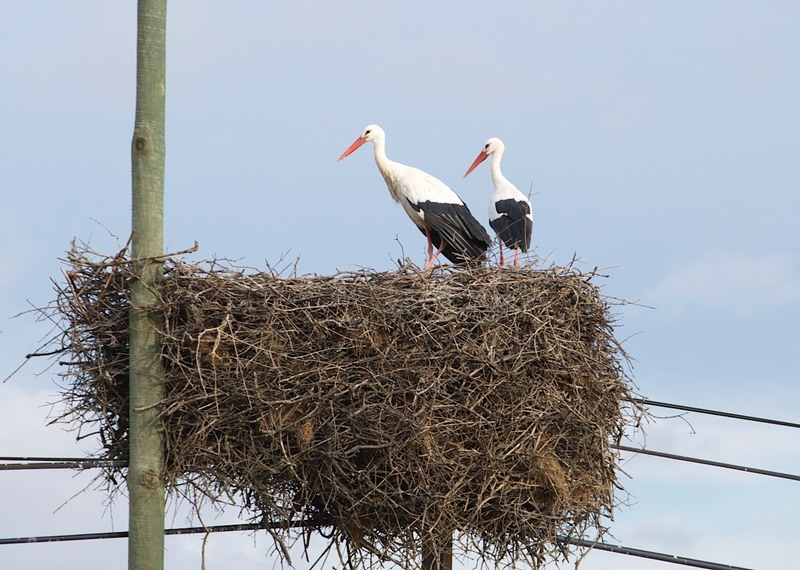
Traveling the countryside, many times we saw black storks nesting in on top of buildings and utility poles; we wonder how the phone company keeps their customers in business. We were surprised to also see baby lambs (in December?), along with goats and pigs. It was just great.
We were able to spend several nights out in the countryside, parked alongside reservoirs or somewhere else in the middle of nowhere. The country was hilly and pleasant. There were olives and grapes, but we never spotted citrus here in the south. One night we cozied up to a large stone circle and communed with the spirits. Portugal has several megalithic sites; they are well maintained and very accessible. This one was huge, 92 stones in all, on a hillside overlooking the city of Évora. It was really cool and made for a great stop.
There’s an interesting area in southern Portugal that is full of marble; so full that even the lowliest little towns have lots of marble buildings and even the streets use marble for the storm drains and curbs and sidewalks. It’s quite startling at first; kind of like “the streets are paved with gold….”
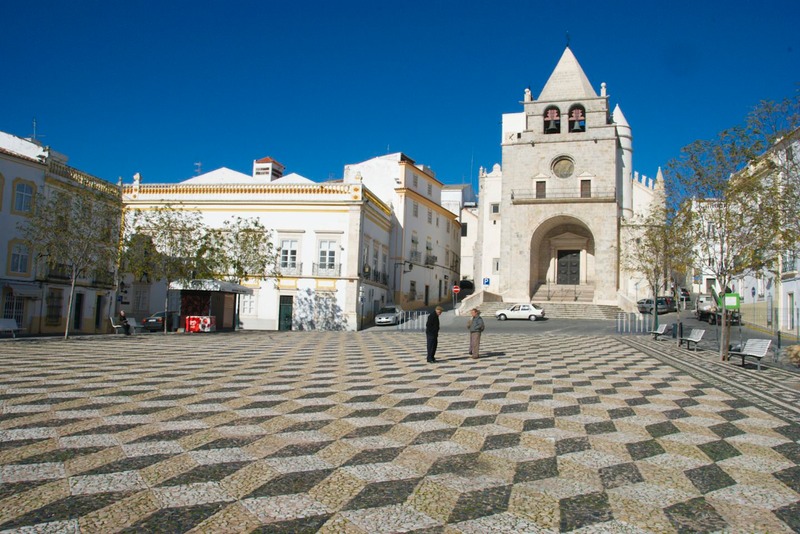
We wanted to visit the fortifications at Elvas; this city is very close to the Spanish border, and like many towns in such positions, there were forts and castles. In Elvas the fortifications are still complete, and surrounded the entire old town. To get there we had to negotiate a 3.0 meter underpass, which caused us some worry. We are precisely 3.0 meters tall; it could have been a real issue. But we crept through, staying in the middle and watching for traffic whipping around a sharp corner that led out at the other end. Just after negotiating the turn we met up with a large truck coming the other way. But he was very patient, and gave us a huge grin and a big thumbs up on getting through, holding up two fingers a couple of inches apart to indicate how close we’d been. So far, that’s the only such trouble we’ve had in this country of small roads to out-of-the-way places.
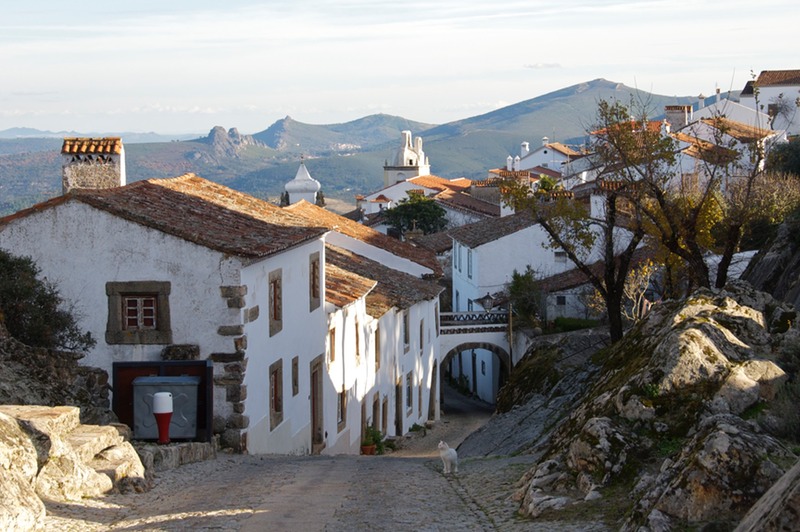
We arrived in Portugal with almost three weeks available before we had to get ready to fly home. We had arranged to store the Tiger in a campground north of Lisbon (our point of departure). Our hope was to see something of the entire country, but also to visit Lisbon, and then we would need a few days at the campground getting ready to put the Tiger in storage. When we first arrived, the weather was generally good, and we had a lovely time wandering about. But now, a week or so later, it was raining a lot, cold, and creating havoc with our “best laid plans.”
In checking on the long-range forecast, it appeared that for the rest of our time in Portugal there would only be a couple of clear days, and that they were coming up soon. Otherwise? Rain. So we hung out for a couple of days while it stormed; after pondering, we decided our best bet was to see Lisbon now, as we might not get another chance.
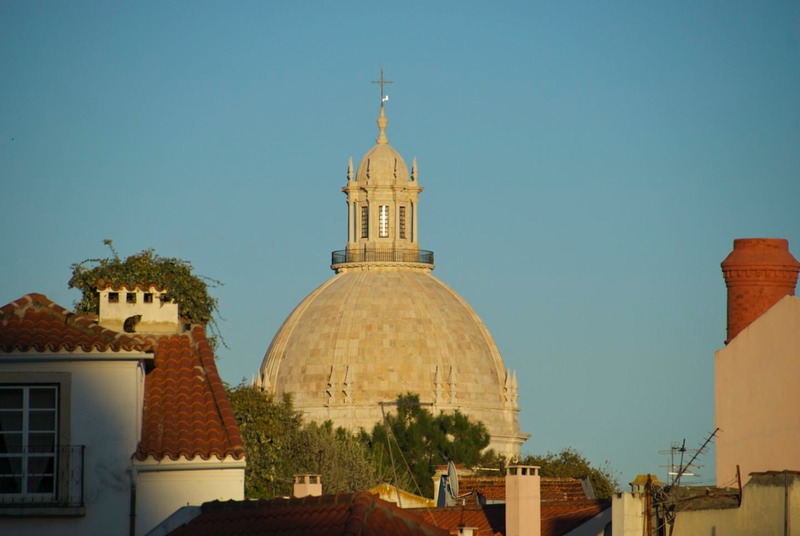
So off to Lisbon. And what a nice place it is! We spent most of three days wandering the sights. We rode the trams, the buses, took the elevator to the top of one of the hills, wore our feet off, saw several museums that knocked our socks off, and had a great time. Lisbon is lovely. Upon the advice of friends we camped out in a parking lot at one of the old docks, newly renovated with restaurants, etc. It wasn’t too expensive, and was quite handy to all the above-mentioned transportation, as well as being close enough to walk to the Rossio, the old city center. All went well except for Friday night, when one of the restaurants apparently was having a rave party complete with a huge portable generator to handle things. It didn’t shut down until after 6:00 the next morning; not much sleep was had by those of us not attending! But it was fine; we’re always fine.
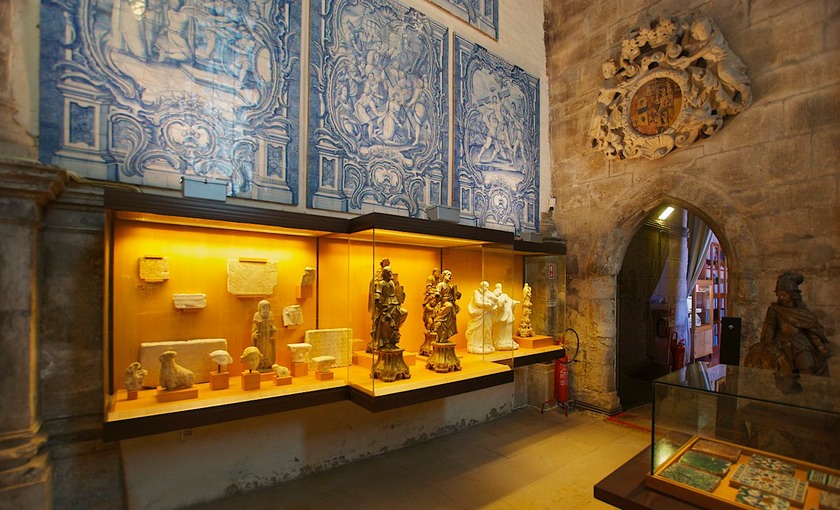
We must tell you about three very special places we visited. The Convento do Carmo is a small museum in the ruins of an ancient convent. Portugal suffered an incredible earthquake in 1755, and much of the city lay in ruins. This church was beautiful before the quake; the ruins are exquisite. The day we were there, we shared the space with a group of children from a nearby international school (we were startled to hear English being spoken all around us), which made it even more special. Ruins are often quiet places of meditation; the kids were having a treasure hunt for specific items they needed to find as part of their schoolwork; it was a very “human” experience. The museum contained historic artifacts related to Portugal’s great international explorations. There were lots of cool things, including some very familiar Peruvian mummies.
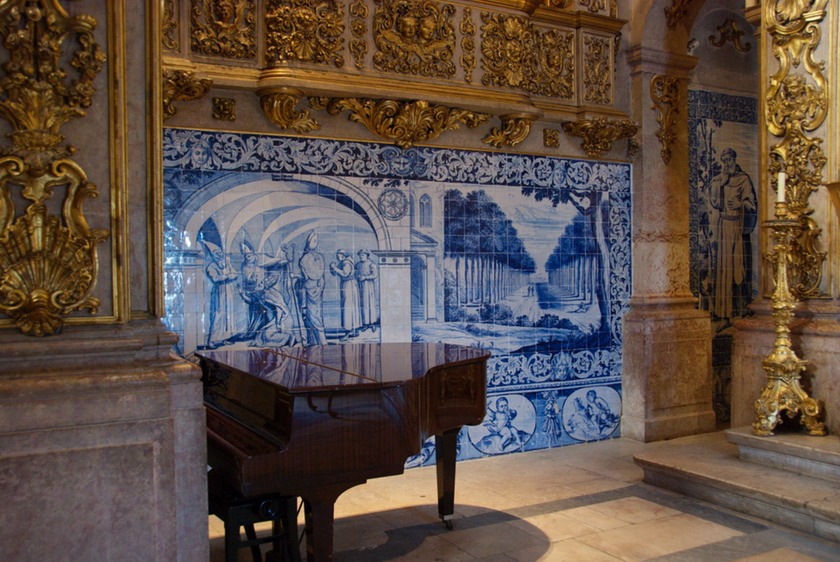
We also visited the Museu do Azulejos; the “tile museum.” Portugal (and Lisbon most of all) is famous for its walls of tile, an historic tradition that was brought to the country by the Moors. They are called azulejos. This museum shows the development of the art through the centuries, and is centered around an old church which has some of the finest examples of the art to be found anywhere. We were overwhelmed by them; there are wonderful exhibits showing how they are made, a spot where you could see them laid out on the floor being assembled, and, in various rooms, examples from various countries in Europe. As often happens, the building housing the museum was almost as much of an attraction as the exhibits. This one included an amazingly ornate and richly decorated chapel among other wonderful features. Very special.
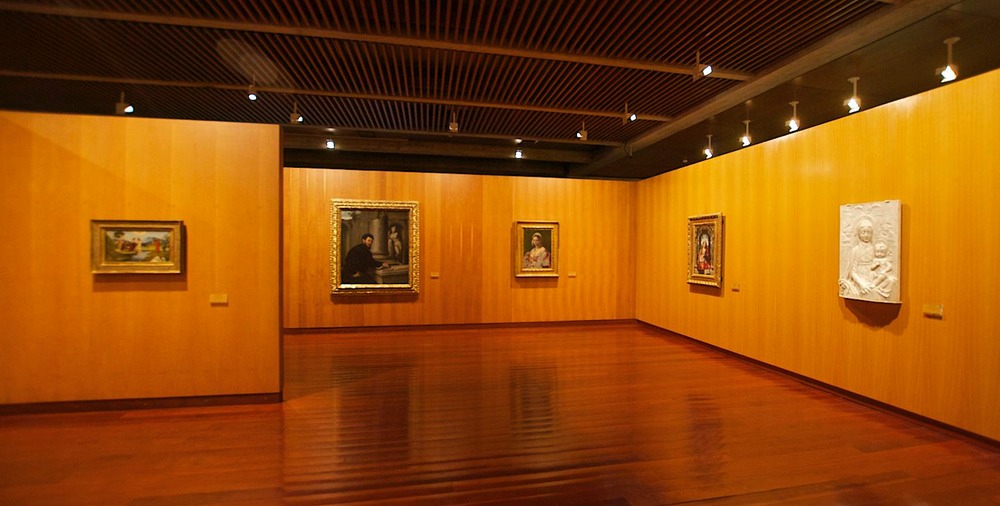
Just before the rain closed in on us we spent a magical morning at the Gulbenkian Museum, housed in a building built for the collection. Unusual for much of Europe, it was horizonal in structure, rather than vertical, and looked a bit like Frank Lloyd Wright’s work. It was in a lovely garden setting, and delightful. This is a private collection, amassed by a man named Gulbenkian, who was an Armenian who settled in Lisbon for the last years of his life. It is a lovely collection of paintings, textiles, furniture and ceramics, along with ancient Egyptian and oriental artifacts, and culminates in a large group of works by Rene Lalique. If you aren’t familiar with Lalique, you owe it to yourself to become acquainted. He blew glass, designed jewelry and furniture, and was incredibly famous in Paris during the Art Deco period. His works are simply awesome. This museum was an absolutely exquisite experience and must not be missed if you have a chance to visit Lisbon.
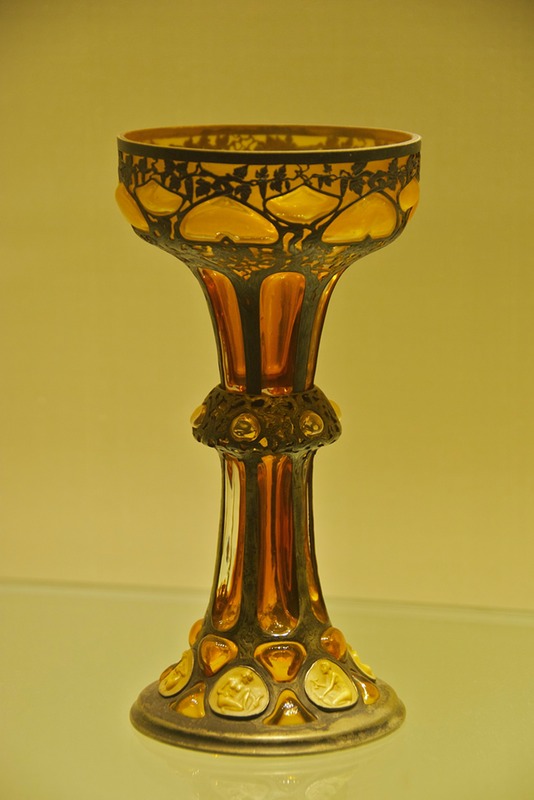
We had much more we wanted to see in Lisbon, but we had started the morning at 37 degrees, we were now getting drenched, and the weather report was for heavy weather for at least the next 8 days. So we bailed; we settled in at the campground to wait out the weather, even if it meant we would have to skip the rest of Portugal for this time around.
And that’s what has happened. We’ve spent the last 10 days working on projects, cleaning and washing and sorting our belongings, and planning for our time in the States. It hasn’t been all bad; we’ve got electricity (splendid!), lots of hot water in the shower block (astounding!!), a friendly staff (magnificent!!!), and birds in the trees (simply glorious). Clothes take several days to dry, but we have the time!
And now we’re back in Lisbon. We left the Tiger in storage at the campground in Vila Franca de Xira. We’ve taken a hotel room for tonight, and tomorrow morning we will fly to Houston. But it won’t be long before we’re back. We can hardly wait! We’ll be heading south to Morocco, but if the weather is good we’ll take a couple of weeks and see the rest of Portugal first.
Best wishes to all for a splendiferous holiday season. See you down the road.
Rick and Kathy
Click here to view more pictures from either Spain, or Portugal.